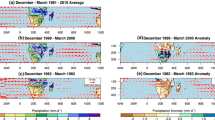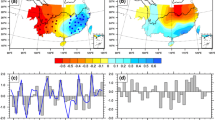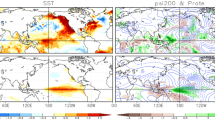Abstract
The climate of Southern Africa, defined as the land area bound by the region 15°S–35°S; 12.5°E–42.5°E, during the December–March rainy season is driven by Indo-Pacific sea surface temperature (SST) anomalies associated with the El Niño Southern Oscillation (ENSO) and the Subtropical Indian Ocean Dipole (SIOD). The observed December–March 1979–2014 Southern Africa precipitation during the four ENSO and SIOD phase combinations suggests that the phase of the SIOD can disrupt or enhance the Southern Africa precipitation response to ENSO. Here, we use a large ensemble of model simulations driven by global SST and ENSO-only SST to test whether the SIOD modifies the relationship between Southern Africa precipitation and ENSO. Since ENSO-based precipitation forecasts are used extensively over Southern Africa, an improved understanding of how other modes of SST variability modulate the regional response to ENSO is important. ENSO, in the absence of the SIOD, forces an equivalent barotropic Rossby wave over Southern Africa that modifies the regional mid-tropospheric vertical motions and precipitation anomalies. El Niño (La Niña) is related with high (low) pressure over Southern Africa that produces anomalous mid-tropospheric descent (ascent) and decreases (increases) in precipitation relative to average. When the SIOD and ENSO are in opposite phases, the SIOD compliments the ENSO-related atmospheric response over Southern Africa by strengthening the regional equivalent barotropic Rossby wave, anomalous mid-tropospheric vertical motions and anomalous precipitation. By contrast, when the SIOD and ENSO are in the same phase, the SIOD disrupts the ENSO-related atmospheric response over Southern Africa by weakening the regional equivalent barotropic Rossby wave, anomalous mid-tropospheric vertical motions and anomalous precipitation.











Similar content being viewed by others
References
Adler RF et al (2003) The version-2 global precipitation climatology project (GPCP) monthly precipitation analysis (1979–present). J Hydrometeorol 4:1147–1167
Allan RJ, Reason CJC, Lindesay JA, Ansell TJ (2003) Protracted’ ENSO episodes and their impacts in the Indian Ocean region. Deep Sea Res Part II Top Stud Oceanogr 50:2331–2347
Behera SK, Yamagata T (2001) Subtropical SST dipole events in the southern Indian Ocean. Geophys Res Lett 28:327–330
Behera SK, Salvekar PS, Yamagata T (2000) Simulation of interannual SST variability in the tropical Indian Ocean. J Clim 13:3487–3499
Behera SK, Luo J-J, Masson S, Delecluse P, Gualdi S, Navarra A, Yamagata T (2005) Paramount impact of the Indian Ocean Dipole on the East African short rains: a CGCM study. J Clim 18:4514–4530
Chambers DP, Tapley BD, Stewart RH (1999) Anomalous warming in the Indian Ocean coincident with El Niño. J Geophys Res Oceans 104:3035–3047
Fauchereau N, Pohl B, Reason CJC, Rouault M, Richard Y (2008) Recurrent daily OLR patterns in the Southern Africa/Southwest Indian Ocean region, implications for South African rainfall and teleconnections. Clim Dyn 32:575–591
Goddard L, Graham NE (1999) Importance of the Indian Ocean for simulating rainfall anomalies over eastern and southern Africa. J Geophys Res Atmos 104:19099–19116
Grove CA, Zinke J, Peeters F, Park W, Scheufen T, Kasper S, Randriamanantsoa B, McCulloch MT, Brummer GJA (2012) Madagascar corals reveal Pacific multidecadal modulation of rainfall since 1708. Clim Past 9:641–656
Hansingo K, Reason CJC (2009) Modelling the atmospheric response over southern Africa to SST forcing in the southeast tropical Atlantic and southwest subtropical Indian Oceans. Int J Climatol 29:1001–1012
Hastenrath S, Greischar L, van Heerden J (1995) Prediction of the summer rainfall over South Africa. J Clim 8:1511–1518
Hoell A, Funk C, Magadzire T, Zinke J, Husak G (2015) El Niño-Southern Oscillation diversity and Southern Africa teleconnections during Austral Summer. Clim Dyn 45:1583–1599
Huffman GJ, Adler RF, Bolvin DT, Gu G (2009) Improving the global precipitation record: GPCP version 2.1. Geophys Res Lett 36:L17808. doi:10.1029/2009GL040000
Hurrell JW, Hack JJ, Shea D, Caron JM, Rosinski J (2008) A new sea surface temperature and sea ice boundary dataset for the community atmosphere model. J Clim 21:5145–5153
Jury MR (1992) A climatic dipole governing the interannual variability of convection over the SW Indian Ocean and SE Africa region. Trends Geophys Res 1:165–172
Jury MR, Mc Queen C, Levey K (1994) SOI and QBO signals in the African region. Theor Appl Climatol 50:103–115
Landman WA, Goddard L (2005) Predicting southern African summer rainfall using a combination of MOS and perfect prognosis. Geophys Res Lett 32:L15809. doi:10.1029/2005GL022910
Landman WA, DeWitt D, Lee D-E, Beraki A, Lötter D (2011) Seasonal rainfall prediction skill over South Africa: one- versus two-tiered forecasting systems. Weather Forecast 27:489–501
Lindesay JA (1988) South African rainfall, the Southern Oscillation and a Southern hemisphere semi-annual cycle. J Climatol 8:17–30
Lyon B, Mason SJ (2009) The 1997/98 summer rainfall season in Southern Africa. Part II: model simulations and coupled model forecasts. J Clim 22:3802–3818
Manatsa D, Matarira CH, Mukwada G (2011) Relative impacts of ENSO and Indian Ocean dipole/zonal mode on east SADC rainfall. Int J Climatol 31:558–577
Manatsa D, Reason CJC, Mukwada G (2012) On the decoupling of the IODZM from southern Africa Summer rainfall variability. Int J Climatol 32:727–746
Manatsa D, Mushore T, Lenouo A (2015) Improved predictability of droughts over southern Africa using the standardized precipitation evapotranspiration index and ENSO. Theor Appl Climatol p 1–16
Mason SJ, Jury MR (1997) Climatic variability and change over southern Africa: a reflection on underlying processes. Prog Phys Geogr 21:23–50
Misra V (2003) The influence of Pacific SST variability on the precipitation over Southern Africa. J Clim 16:2408–2418
Nicholson SE (1997) An analysis of the enso signal in the tropical atlantic and western indian oceans. Int J Climatol 17:345–375
Nicholson S, Entekhabi D (1986) The quasi-periodic behavior of rainfall variability in Africa and its relationship to the southern oscillation. Arch Met Geophys Bioclim A 34:311–348
Nicholson SE, Kim J (1997) The relationship of the el niño–southern oscillation to african rainfall. Int J Climatol 17:117–135
Ratnam JV, Behera SK, Masumoto Y, Yamagata T (2014) Remote effects of El Niño and Modoki events on the Austral summer precipitation of Southern Africa. J Clim 27:3802–3815
Reason CJC (2001) Subtropical Indian Ocean SST dipole events and southern African rainfall. Geophys Res Lett 28:2225–2227
Reason C (2015) Tropical south east Atlantic warm events and associated rainfall anomalies over southern Africa. Front Environ Sci 3:24
Reason CJC, Jagadheesha D (2005) A model investigation of recent ENSO impacts over southern Africa. Meteorol Atmos Phys 89:181–205
Reason CJC, Rouault M (2002) ENSO-like decadal variability and South African rainfall. Geophys Res Lett 29:16-11–16-14
Reason CJC, Allan RJ, Lindesay JA, Ansell TJ (2000) ENSO and climatic signals across the Indian Ocean Basin in the global context: part I, interannual composite patterns. Int J Climatol 20:1285–1327
Rocha A, Simmonds IAN (1997) Interannual variability of South-Eastern African summer rainfall. Part 1: relationships with air–sea interaction processes. Int J Climatol 17:235–265
Roeckner E et al (2006) Sensitivity of simulated climate to horizontal and vertical resolution in the ECHAM5 atmosphere model. J Clim 19:3771–3791
Rouault M, Florenchie P, Fauchereau N, Reason CJC (2003) South East tropical Atlantic warm events and southern African rainfall. Geophys Res Lett 30(5):8009. doi:10.1029/2002GL014840
Saha S et al (2013) The NCEP climate forecast system version 2. J Clim 27:2185–2208
Saji NH, Yamagata T (2003) Possible impacts of Indian Ocean Dipole mode events on global climate. Climate Research 25:151–169
Saji NH, Goswami BN, Vinayachandran PN, Yamagata T (1999) A dipole mode in the tropical Indian Ocean. Nature 401:360–363
Wang B et al (2009) Advance and prospectus of seasonal prediction: assessment of the APCC/CliPAS 14-model ensemble retrospective seasonal prediction (1980–2004). Clim Dyn 33:93–117
Washington R, Preston A (2006) Extreme wet years over southern Africa: Role of Indian Ocean sea surface temperatures. J Geophys Res Atmos 111
Webster PJ, Moore AM, Loschnigg JP, Leben RR (1999) Coupled ocean-atmosphere dynamics in the Indian Ocean during 1997-98. Nature 401:356–360
Wyrtki K (1975) El Niño—the dynamic response of the equatorial Pacific Oceanto atmospheric forcing. J Phys Oceanogr 5:572–584
Yuan C, Tozuka T, Landman W, Yamagata T (2014) Dynamical seasonal prediction of Southern African summer precipitation. Clim Dyn 42:3357–3374
Zinke J, Pfeiffer M, Timm O, Dullo WC, Brummer GJA (2009) Western Indian Ocean marine and terrestrial records of climate variability: a review and new concepts on land-ocean interaction since A.D. 1660. Int J Earth Sci 98:115–131. doi:10.007/s00531-008-0365-5
Acknowledgments
The authors thank Dave Allured for completing the ECHAM5.4 simulations and Tao Zhang for completing the GFSv2 simulations. The authors are grateful for support from the Famine Early Warning Systems Network (FEWS NET).
Author information
Authors and Affiliations
Corresponding author
Rights and permissions
About this article
Cite this article
Hoell, A., Funk, C., Zinke, J. et al. Modulation of the Southern Africa precipitation response to the El Niño Southern Oscillation by the subtropical Indian Ocean Dipole. Clim Dyn 48, 2529–2540 (2017). https://doi.org/10.1007/s00382-016-3220-6
Received:
Accepted:
Published:
Issue Date:
DOI: https://doi.org/10.1007/s00382-016-3220-6




